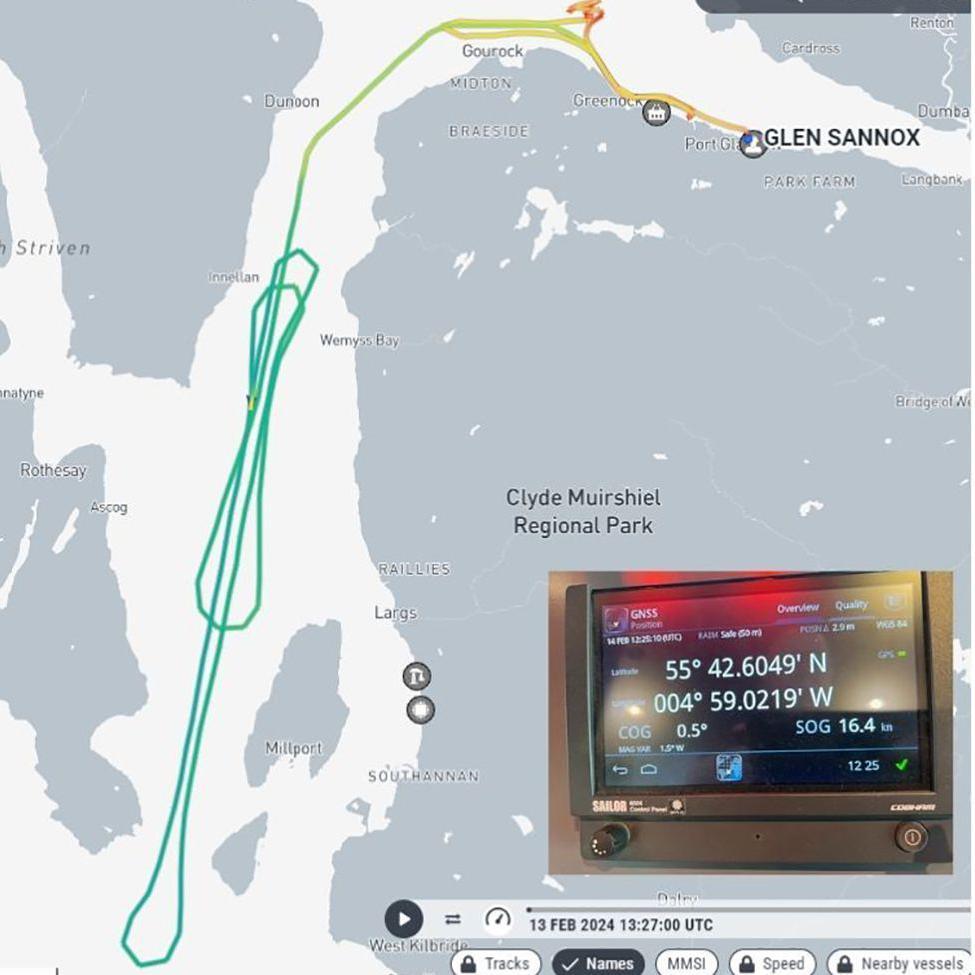Glen Sannox sea trials 'overwhelmingly positive'

- Published
One of the delayed ferries being built at Ferguson shipyard has successfully completed the first stage of its sea trials.
MV Glen Sannox travelled down the Clyde from Port Glasgow as far as Cumbrae as its engines, navigation systems and generators were tested.
Ferguson Marine chief executive David Tydeman said the initial four days of trials had been "overwhelmingly positive".
The nationalised firm said the speeds achieved confirmed the ship would be able to operate as required on the Arran route this summer.
Long-delayed ferry Glen Sannox finally sets sail
Staff from marine firm Lloyds Register were on board for some of the trials, monitoring technical standards.
The ship reached a maximum speed of 16.7 nautical miles per hour or "knots" but this was a "speed on the ground" measurement so could include tidal flows and currents.
However, the yard estimated it was travelling at just under 16 knots through the water so it should have no problem reaching the 14.5 knots speed required for the Arran route where it will initially operate.
The contract requires it to be able to reach 16.5 knots, and that will be assessed during "owner's trials" later in the year.
These will be conducted after a visit to dry dock in April which will clear off any marine growth from the hull that could slow the ship down.
Long-delayed Ferguson ferry begins sea trials
- Published13 February 2024
The Ferguson ships nobody talks about
- Published26 November 2023
Mr Tydeman said: “The results of this first phase of trials have been overwhelmingly positive, clearly demonstrating the advanced technology which MV Glen Sannox will bring to the CalMac fleet.
"Next steps for the vessel will be a return to the Ferguson Marine quayside, where she will undergo further outfitting and LNG system work before a trip to the dry dock in early April."
In April and May, Glen Sannox will also undergo endurance tests - when it will operate at higher speeds for longer periods of time.
The ship was originally due for delivery in 2018 but the project ran into difficulties as the yard, then owned by Jim McColl's investment firm Clyde Blowers, struggled with design challenges.
The businessman later claimed the concept design, which was the responsibility of ferries procurement agency CMAL, was flawed and that contract was put out to tender with important issues unresolved.
CMAL disputes that, claiming the problems arose because of contractor failure.
The shipyard went into administration in 2019 and was subsequently nationalised but delays and costs continued to rise.

Glen Sannox travelled as far south as Cumbrae and Bute
Glen Sannox will eventually be able to run on either conventional marine diesel or liquefied natural gas (LNG) but the gas systems have not yet been commissioned due to a delay in obtaining essential parts.
An update on when exactly it will be handed over to CalMac for the ferry operator to conduct its own sea trials is expected next week.
Along with its sister ship Glen Rosa - which is still being built at the shipyard - Glen Sannox will be the first and only LNG-powered ships ever built in the UK.
A dedicated LNG refuelling facility was due to be built as part of a redevelopment of Ardrossan harbour, which was announced six years ago.
But that has stalled and the ships will initially have to be refuelled from tankers instead.
The ships are also too large to use the current berth at Ardrossan, so are expected to begin their working life sailing from Troon to Brodick.
Four other new CalMac large ferries, with less sophisticated propulsion systems and smaller cargo capacities, are currently under construction in Turkey.
The first of them, Isle of Islay, is due for launch next month and could be delivered later in the year.